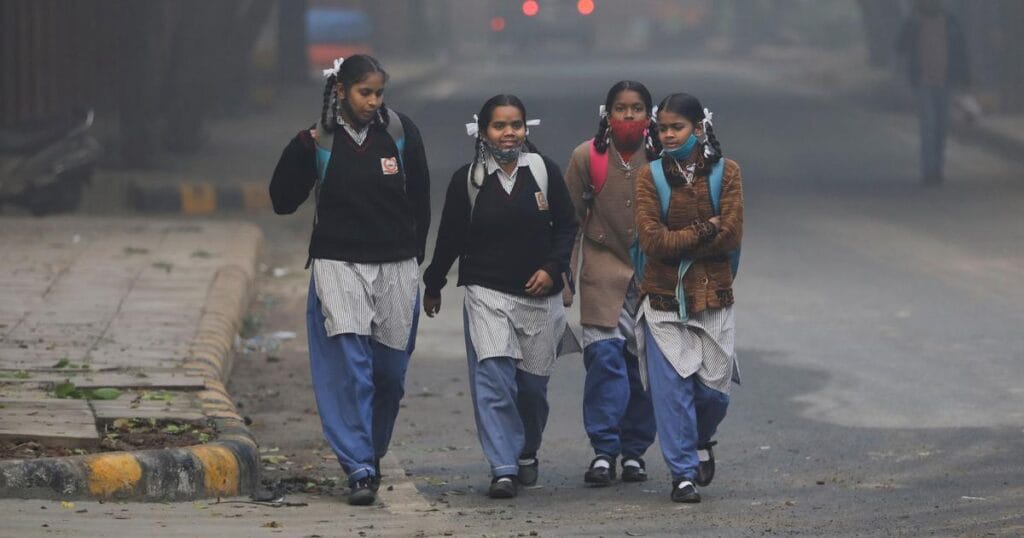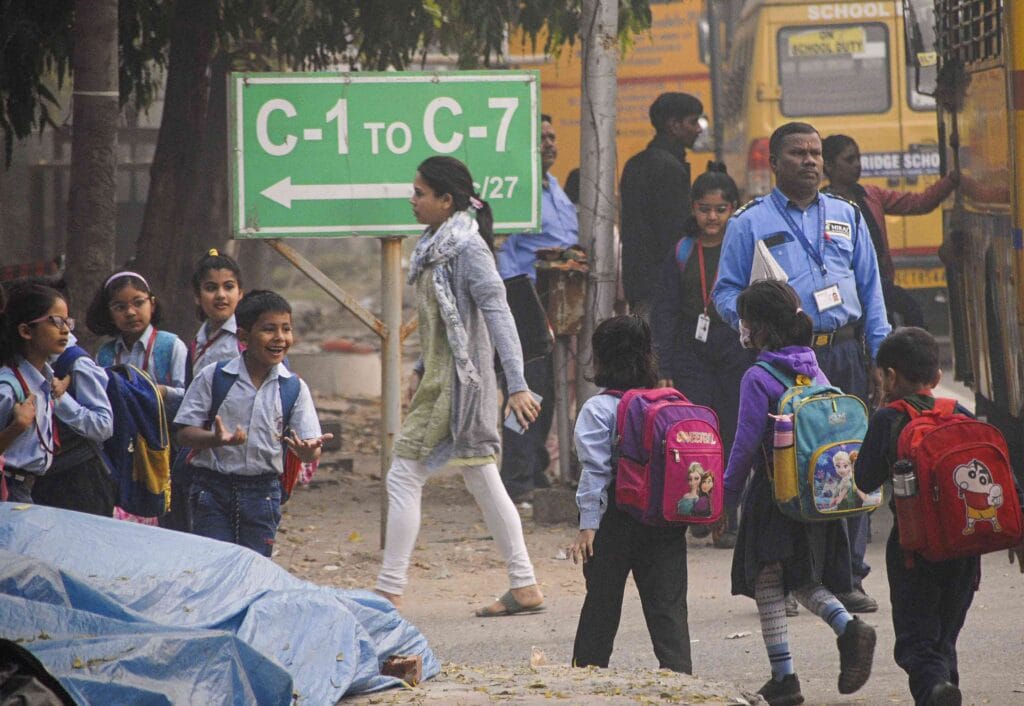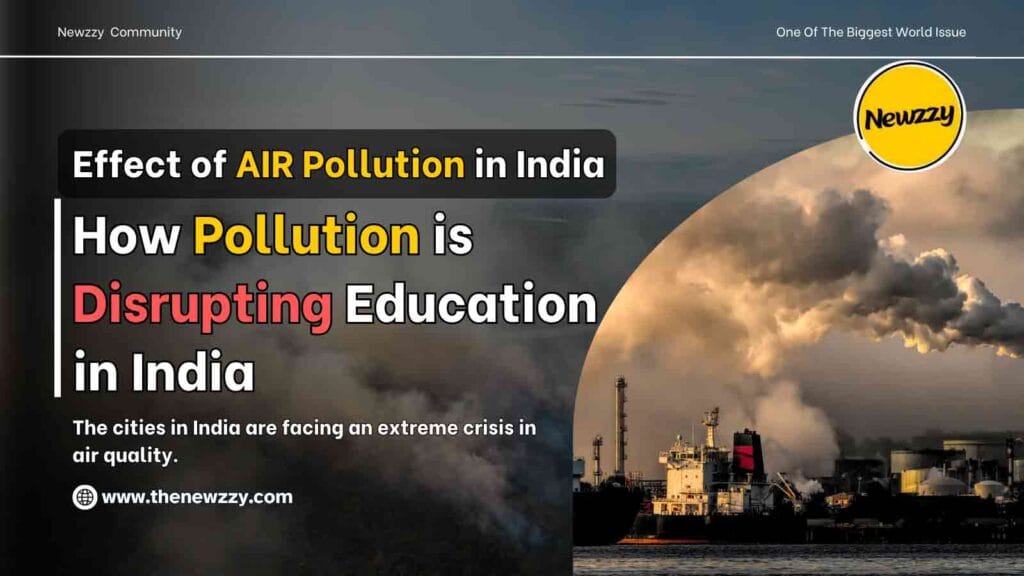Air pollution in India: The fast rates of urbanization and industrialization that have taken place in India, although beneficial to economic growth, have also seen the levels of air pollution in india’s key cities raising to an alarming rate. The particulate matter (PM2.5 and PM10) frequently exceeds the safe levels by significant range as the World Health Organization (WHO) regularly includes several Indian cities in the list of the most polluted cities worldwide.
Though much attention has been brought to the fact that this environmental degradation is a public health crisis, little attention has been brought to the actual implications this has on the education sector specifically school attendance. To fill this gap, this article aims to look at the various aspects through which rampant air pollution in cities is disimportant to the educational life of millions of Indian children.
Table of Contents
Education is a human right and it is guaranteed in the constitution of India. Yet this right is threatened by the silent killer that is air pollution which comes in many forms of disruption. Whether through direct health effects that cause absenteeism, the possible cognitive effects and the drastic solution of closing schools during bad pollution episodes, the air that children breathe is increasingly shaping the educational scene in urban India.
Read About: Top Indian Green Technology Startups in 2025
This knowledge is important to design specific interventions safeguarding the health of children as well as their right to quality education.
In this paper, the data related to air quality monitoring (Central Pollution Control Board, CPCB), the information related to child health, and welfare (UNICEF) as well as the scholarly articles with the empirical evidence related to the connection between air pollution, and school attendance are synthesized to provide the comprehensive image of the urgent problem.
Air Pollution in Indian Cities are Alarming
The cities in India are facing an extreme crisis in air quality. The official statistics provided by the Central Pollution Control Board (CPCB) and other independent air quality monitoring organizations always give a very bleak image. Such cities as Delhi, Ghaziabad, Kanpur, Lucknow, and Mumbai are regularly included in the list of the most polluted cities in the world.
Fine particulate matter (PM2.5) and coarser particulate matter (PM10) are the main pollutants of concern. PM2.5 is microscopic in size and can therefore get deep into the lungs, and even get into the bloodstream, leading to systemic health damages.
Air Pollution in Delhi Report
CPCB data show that the Air Quality Index (AQI) values recorded in several Indian cities on a frequent basis are either in the Poor, Very Poor, or Severe category, especially in the post-monsoon season and during winter. As an example, in real-time, the AQI in Delhi frequently reaches high values, being in the range of the “Very Poor” and “Severe” on the scale, which means that the entire population is at high risk of facing health-related issues.
Although the accurate historic annual averages in all cities would need much data to be pulled out of CPCB archives, the very fact that the reporting is consistent indicates that a large section of the urban child population is breathing air quality that is way below the national and international safety limits. This long term exposure provides the back drop or background to the disruptions in education.
This pollution has varied and multiple sources, including vehicular emissions, industrial effluence, and construction dust, biomass burning and agricultural stubble burning in the adjoining areas, all of which added to a toxic mix of contaminants in the city air.
Effects of AIR Pollution on Health Especially on Children

Air pollution has a grim impact on children because of their developing lungs, higher rate of breathing and their tendency to be closer to the ground. Report after report by UNICEF had indicated how air pollution has had devastating effects on the health of Indian children. These effects directly correspond into educational losses.
In its analyses, UNICEF again and again stresses that such environmental stressors as air pollution or heatwaves are having a negative impact on their health, school attendance, and overall learning outcomes.
Air pollution in india: One grim report in a recent UNICEF report (January 2025) reveals that, as of 2021, Air pollution was the second major risk factor in causing death in children under five, following malnutrition, and on a global scale, an enormous 709,000 deaths of children under five were attributed to air pollution. Although this is a worldwide number, it highlights how badly young children are susceptible to filthy air, and this is an experience that is heavily realized in India.
The short-term health impacts are respiratory infections (such as pneumonia and bronchitis), asthma attacks and allergies. Long-term exposure may cause retardation of lung development, slowed cognitive ability and raised chances of developing chronic illness in adulthood. These medical conditions have direct impact on school attendance.
Children with respiratory conditions have a higher chance of missing school days because of sickness, visits to the doctor, and recovery. Parents, wanting the best to be healthy, can also decide to keep their children at home on the days when the air quality is exceptionally bad.
Besides physical deteriorations, found evidence suggests the neurodevelopmental effects of air pollution.
It is hypothesized that exposure to fine particulate matter can cause neuroinflammation and oxidative stress in the brain areas that are most important in memory and learning which may result in the declined cognitive functioning, attention span, and academic achievement, even on the days when the children are in the school. Although this effect on learning may be small yet it has a potentially long-lasting implication on the overall education path and future of the child.
Air Pollution in India: The operations of UNICEF in India such as the incorporation of climate change learning in the national curriculum and the promotion of Comprehensive School Safety Programmes (CSSP) silently recognize how environmental hazards, such as air pollution, pose a danger to a safe and healthy learning environment. Such efforts, important as they are, also reveal the magnitude of the problem that would require more comprehensive policy measures to reduce pollution source.
Pollution is Damaging Education in India

The empirical research that specifically looks at the association between air pollution and school attendance in India is strong evidence of the interference. One of the most influential studies, the article by Singh (2020) titled Beyond The Haze: Air Pollution and Student Absenteeism – Evidence from India provides comprehensive empirical data on the mentioned critical connection.
Air Pollution in India: The research uses local exposure to fine particulate matter (PM2.5) and school attendance records, providing evidence of a significant adverse impact of air pollution on student attendance on days with high air pollution levels.
This impact is found to be stronger on younger students as indicated in the research by Singh especially considering that young students are more susceptible to respiratory diseases. In addition, the research points towards the existence of differential effects along the gender axis, which points towards the possibility of girls being affected more but the causes of which have to be investigated further.
One major way through which this greater absenteeism has been found to operate is the fact that there is a greater occurrence of respiratory conditions among the students who are more exposed to air pollution. At high pollution days children are more likely to experience coughs, colds, asthma attacks and other respiratory inconveniences and therefore may find it impossible or difficult to go to school.
Although, more specifically, publicly available, nationwide granular attendance reports directly correlated with air pollution events are few, such as those used in research such as Singh (2020), such a connection can be seen in the datasets used. In addition to the individual absenteeism, there have been mass school closures in the major Indian cities especially in the National Capital Region (NCR) due to severe air pollution incidents.
How to Reduce Air Pollution?
This calls for a multi-pronged approach to the consideration of the problem of air pollution affecting schooling attendance in Indian cities; while through a misjudgment might consider the mitigation of environmental impact, safeguarding measures at the level of schooling must be placed.
Pre-emptive Air Pollution Abatement
Strict Enforcement of an Emission Standards Regime: An emission norm from industries, vehicles, and construction activities must be strictly enforced and strengthened. Monitoring activity, which also checks preponderance of doubt in incidences of non-compliance, shall be considered in the case of sanctioning.
Encouraging Use of Public Transport and Electric Cars
Serious investments shall be considered toward creating strong, efficient, and affordable public transport systems and measures to encourage the use of electric cars for the curb of vehicular emissions.
Agricultural Stubble Burning
Proper policies and economic compensations may be necessary to provide alternatives for stubble burning to farmers, especially in cities suffering due to transboundary air pollution.
Green Infrastructure Development
Urban forestry, development of green areas, and investments in renewable energy can clean the air.
Granular Real-Time Air Quality Monitoring
It is of utmost importance to increase the number of air quality monitoring stations, especially in the vicinity of schools, so as to obtain granular and easy-to-comprehend data in real-time.
How to Reduce Air Pollution To Safeguard Educational Continuity

Some School-specific Air Quality Protocols: On high pollution days, schools should have protocols to recommend activities to do indoors, use of air purifiers (when practical and affordable), and even closure decisions.
Improving IAQ in Schools: Ventilation, air filtration, and green building concepts are all methods of investing in indoor air quality for schools, concentrating more on those more established.
Health Support: There needs to be preparation in schools for the health effects of pollution, such as trained personnel and basic health services. The curriculum should also include health education to students on coping mechanisms for pollutants.
Flexible Learning Modalities: During unavoidable school closures, strong online learning platforms and remote education solutions must be deployed to ensure the continuity of education for especially disadvantaged students. This calls for bridging the digital gap.
Integrating Environmental Education: Extending from UNICEF’s initiatives, the system must introduce climate change and air pollution education, thus equipping students to understand the issue better, stand up for change, and adopt healthier practices in daily life.
Summary and Recommendations About Air Pollution in India
The facts are strongly pointing towards the hypothesis that air pollution is a serious menace to education in metropolitan cities in India. In addition to the widely-reported health impacts, the worsening air quality causes higher school absenteeism, prevents cognitive development, which altogether undermine the quality and availability of education.
The consequences of this cannot be stressed enough on the development of human capital in India in the long run as this generation of students is at risk of poor health and learning outcomes.
Air Pollution in India: Challenges are not easy and are interwoven with issues of urbanization, industrialization, and socioeconomic issues. Nevertheless, the destiny of millions of children depends on active and urgent measures. India can reduce this crisis by focusing on aggressive air pollution reduction measures along with focused measures to ensure education continuity and to enhance indoor air quality in schools.
Moreover, it is necessary to have a strong research and data collection to drive evidence-based policies. The first significant stride towards guaranteeing that all children in urban India have a chance to learn, grow, and fulfill their potential, unhampered by the haze, would be to recognise air pollution not only as an environmental issue but as a core barrier to the right to education.
References About Air Pollution in India
- D.E. Bloom et al.The contribution of population health and demographic change to economic growth in China and IndiaJournal of Comparative Economics(2010)
- T. Chakraborty et al.School feeding and learning achievement: Evidence from India’s midday meal programJournal of Development Economics(2019)
- H. Chen et al.Exposure to ambient air pollution and the incidence of dementia: A population-based cohort studyEnvironment International(2017)
- O. Deschenes et al.The effect of air pollution on body weight and obesity: Evidence from ChinaJournal of Development Economics(2020)
- S. Dey et al.Variability of outdoor fine particulate (PM2.5) concentration in the indian subcontinent: A remote sensing approachRemote Sensing of Environment(2012)
- Qiuli Fu et al.Air pollution and outpatient visits for conjunctivitis: A case-crossover study in hangzhou, ChinaEnvironmental Pollution(2017)

